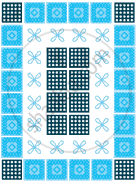Advertisements
Advertisements
Question
11 men can dig \[6\frac{3}{4}\] metre long trench in one day. How many men should be employed for digging 27 metre long trench of the same type in one day?
Solution
Let x be the number of men required to dig a trench of 27 metre.
| Number of men | 11 | x |
| Length (in m) |
\[\frac{27}{4}\]
\[\frac{27}{4}\]
|
27 |
\[\text{ Since the length of the trench and the number of men are in direct variation, we have: } \]
\[\frac{11}{x} = \frac{27/4}{27}\]
\[ \Rightarrow 11 \times 27 = x \times \frac{27}{4}\]
\[ \Rightarrow x = \frac{11 \times 27 \times 4}{27}\]
\[ = 44\]
\[\text{ Thus, 44 men will be required to dig a trench of 27 metre } .\]
APPEARS IN
RELATED QUESTIONS
Suppose 2 kg of sugar contains 9 × 106 crystals.
How many sugar crystals are there in
- 5 kg of sugar?
- 1.2 kg of sugar?
A 5 m 60 cm high vertical pole casts a shadow 3 m 20 cm long. Find at the same time the height of a pole which casts a shadow 5 m long.
Complite the following table given that x varies directly as y .
| x | 5 | ... | 10 | 35 | 25 | ... |
| y | 8 | 12 | ... | ... | ... | 32 |
A can do a piece of work in 40 days and B in 45 days. They work together for 10 days and then B goes away. In how many days will A finish the remaining work?
6 men can complete the electric fitting in a building in 7 days. How many days will it take if 21 men do the job?
If the cost of 6 cans of juice in ₹ 210, then what will be the cost of 4 cans of juice?
Length of a side of a square and its area vary directly with each other.
If x and y are in direct proportion, then (x – 1) and (y – 1) are also in direct proportion.
Write whether the following statement vary directly, vary inversely with each other, or neither of the two.
The quantity of rice and its cost.
Work with a partner to write at least five ratio statements about this quilt, which has white, blue, and purple squares.

How many squares of each colour will be there in 12 such quilts?
